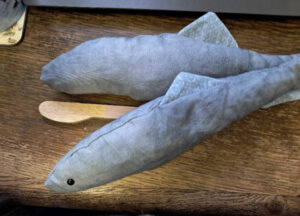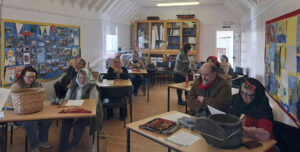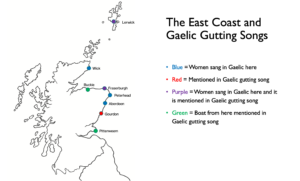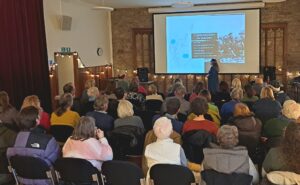Seachdain na Gàidhlig 2024
This year I partnered with Fife Council, the Scottish Fisheries Museum, and the Anstruther Improvements Association to present two events for World Gaelic Week. Seachdain na Gàidhlig, or World Gaelic Week, is held every year to celebrate Scottish Gaelic language and culture. Fife Council’s Gaelic Community Development officer, Kirsty Strachan, worked tirelessly to prepare a slew of events across Fife to celebrate Gaelic. I was involved in two of these events, both held on Saturday 24th of February.
The first was Gut-a-long, Sing-a-long at the Scottish Fisheries Museum. This workshop focused on leading the participants through a discussion and singing session focused on the Gaelic songs of the herring gutters. For this event I chose to focus on Mary Morrison’s version of a common herring gutters’ song, “Air tìr a-raoir, ‘s air muir a-nochd.” A herring gutter from Barra, Mary Morrison was known in her native tongue as Màiri Eòghainn Mhòir, or Mary, the daughter of big Ewan. In the 1920s, she composed several new verses to this popular gutting song. You can hear her sing it here.
The museum staff provided participants with a variety of props that really enhanced the experience for everyone. There were handmade fabric herring stuffed with colourful fabric fish guts. Participants attempted to gut the fish in time with the song, much as the herring gutters would have sometimes done. They were also supplied with headscarves in the style traditionally worn by many Scottish herring gutters, wooden knives, and a variety of barrels and baskets for packing their freshly gutted fish.

Handmade fabric herring © The Scottish Fisheries Museum

The Gut-a-long, Sing-a-long workshop © The Scottish Fisheries Museum

Two participants gut fabric fish © The Scottish Fisheries Museum
We originally expected the attendees of this event to be children and their families. However, most of the participants were adult Gaelic learners. The museum staff and I adjusted the workshop on the fly to open up a more adult discussion of the content of the herring gutters’ songs. This led to a lively discussion in both English and Gaelic about the way working women sang about their love lives in the fishing industry. The Gut-a-long, Sing-a-long received good feedback. Participants wished there had been more than one song to learn, so I added an extra singalong gutters’ song to the presentation I was giving later that afternoon.
That brings us to the second Seachdain na Gàidhlig event, a public talk at the Dreel Halls entitled Gaelic Songs in Fife and the Herring Gutters. 37 people attended, travelling from all over Fife and Dundee to join us in Anstruther. In this talk, I focused on how the herring industry fostered the connections between Fife and Gaelic-speakers. The songs of the herring gutters include valuable linguistic and cultural information, revealing the extent of their interaction with Scots-speaking colleagues in the fishing industry. Gaelic would have been heard all around the East Coast up until the Second World War, after which Hebridean people’s employment in East Coast fisheries dropped off sharply. But for decades before, the herring gutters were heard singing in Gaelic in ports around the East Coast. They even named East Coast boats in some of their songs.

Excerpt from the PowerPoint presentation, mapping connections between Gaelic song and the East Coast of Scotland © Meg Hyland
We sang two Gaelic songs together. One was Mary Morrison’s song mentioned above. The other was a Gaelic song called “Rionnag às an oidhche fhrasaich.” This song was sung by herring gutters but also as a waulking song and a spinning song, showing the adaptability of Gaelic work songs to different tasks. After some technical difficulties, we also got to hear archival recordings of Mary Morrison and Morag Johnson of South Uist singing gutting songs.

Talk attendees at Meg Hyland’s presentation at the Dreel Halls © Anstruther Improvements Association
Feedback to both events was very positive. Participants enjoyed the interactive activities, and many remarked on how they’d enjoyed singing Gaelic songs and learning more about the herring gutters’ history.
I gained a new appreciation for the interchange between Gaelic and Scots speakers in Fife!
Extremely informative, evocative and enjoyable. Glad we got to hear the songs.
Dressing up and gutting fish was great, especially along with the song.
The expertise, knowledge and enthusiasm shown and shared was great.
I did not realise how many Gaelic workers were in Fife.
Meg is a great speaker and really delivered an engaging talk. Plus, learning to sing some songs with her was lots of fun. Also, the talk was clear and enjoyable without missing depth of content.
I know the area I live in a bit more. I also feel more part of the Anstruther community.
‘S math a rinn sibh.
[I will] practice with my little boy who is learning Gaelic songs at school.
I’d like to thank Kirsty Strachan, Julia Branch, Jen Gordon, and Julia Priestley for making this event possible and for facilitating my involvement. Disruptions due to the pandemic and my own health have meant that I haven’t been able to do as many public engagement activities in person as I used to do. Delivering these two events made me more confident again. It was great to see so much enthusiasm for Gaelic songs and local history in Anstruther. I also learned things from the audience, such as information a local resident who grew up in Barra shared with me about the later phases of the herring industry there. This reinforces why “fieldback” is an important part of my research process. Sharing my research with wider communities not only disseminates what I’ve learned, but enhances the research itself. Community feedback and interest are vital parts of shaping my research process. Mòran taing!




I would love to hear some of these herring gutter and p as vaker songs , sung by local women with the right dialects!
Aldo are their any original recordings of songs sung whilst at work ?
Hi David, thanks for your comment. You can find links to recordings of Gaelic songs sung during gutting work on a previous post of mine on the blog: https://blogs.ed.ac.uk/s1848641/2022/05/27/new-article-on-gaelic-gutting-songs/